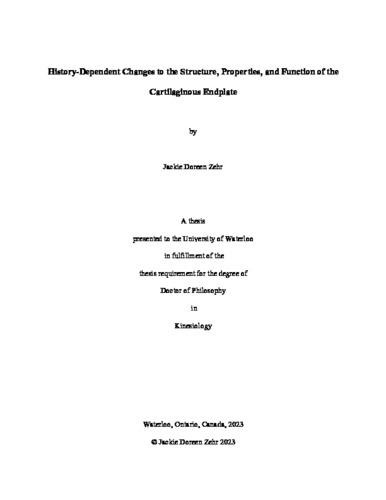| dc.description.abstract | The performance of manual lifting is associated with 33-51% of incidental low back injuries in work, leisure, and sport/exercise contexts. To effectively prevent low back injuries and evaluate the risk of occurrence, knowledge on the fundamental pathways of microscopic damage accumulation in lumbar spine tissues is required and lacking in the literature. This thesis broadly explored this knowledge gap in the cartilaginous endplate (CEP), which is a hypothesized origin for compression-induced low back injuries and degenerative changes to the intervertebral disc. Therefore, the global objectives of this dissertation included: 1) to quantify the effect of cyclic compression paradigms on the properties and microstructure of the cartilaginous endplate; 2) to examine the effect of cyclic loading parameters on microscopic and macroscopic injury patterns in the cartilaginous endplate; and 3) to characterize the cycle-dependent ultimate compression trajectories in response to acute loading histories. To address these objectives, in vitro mechanical testing and immunofluorescence staining techniques were developed and performed on intact spinal units and isolated CEP tissue.
The effects of joint posture, variation in peak compression force, and loading duration on
cycle-dependent changes to spinal joint mechanics, isolated CEP properties, and the pathways of microstructural and constitutive damage were quantified. Compared to neutral joint postures, cyclic loading applied to flexed spinal joints reduced the ultimate strength and CEP stiffness at a given loading duration, irrespective of the peak compression variation. An effect of peak compression variation was observed only within neutral postures and beyond the approximate mid-point of the joint lifespan; a 40% variation reduced the joint strength and CEP stiffness compared to the 10% and 20% variation groups. These altered mechanical properties were supported by evidence of sub-surface microstructural void development followed by damage to native type II collagen proteins within the central CEP region. Data obtained from these in vitro mechanical tests were then used to mathematically characterize the relationships between UCT and loading duration. The second-order polynomial functions demonstrated the depreciation of ultimate compression tolerance and altered safety margins for a given loading history. These data collectively highlighted the importance of spinal joint posture for mediating the damage cascade, which can inform the priorities of job (re)design, clinical intervention, and movement training.
The morphology of microstructural injury patterns was also driven by joint posture during sub-threshold cyclic loading, and the lesion size generally progressed as a function of loading duration. That is, cartilage microfractures were more common in neutrally positioned joints, while avulsion and node microinjuries were most common in flexed spinal units. However, on a macroscopic level, the failure morphology was less sensitive to posture and was attributed to the pace of damage accumulation in the sub-chondral bone relative to the hyaline cartilage surface. This notion was experimentally demonstrated by imposing targeted trabecular bone strength deficits within intact vertebrae and performing subsequent fatigue testing. Initially healthy spinal joints resulted in fracture lesions, while spinal joints with pre-existing strength deficits resulted in Schmorl’s nodes over 50% of the time. This dissociation of macroscopic injury mechanisms provided new insights into their prevention, treatment, and diagnosis and ultimately improves the specificity of ergonomics tools that are developed from in vitro experimental data.
Overall, this research documents the effects of joint posture, variation in peak compression force, and loading duration on the pathways and time-course of microscopic damage in the cartilage endplate of the spine. These data will be used to broadly inform task design, load management, and injury prevention initiatives in many occupational sectors, specifically public protection (i.e., military, emergency response personnel), health care, manufacturing, and professional/colligate sport where low back injuries are a common and costly cause of personal disability and lost work time. The work of this thesis further advanced the methodology used within the broader field of spine biomechanics and the experimental results represent a significant step to understanding the mechanisms and prevention of lifting-related overuse injuries in the lumbar spine. | en |

